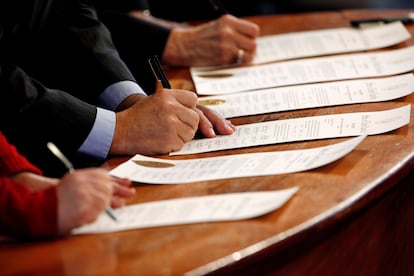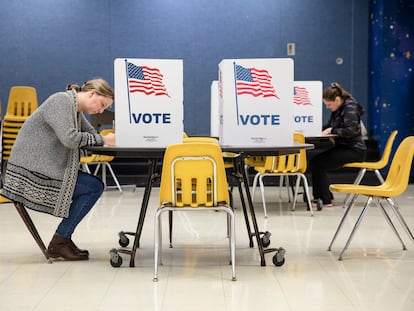How does the Electoral College work and why will it decide the next president?
In five occasions, this system has awarded the presidency to candidates who did not win the popular vote


In the 2000 U.S. election, the Democratic presidential candidate Al Gore won the popular vote with a difference of 0.5% over his Republican challenger George W. Bush. Despite this, the Electoral College awarded the victory to Bush as he secured five more electors than Gore. In 2016, Democrat Hillary Clinton won almost 3 million more votes than Donald Trump, however, the Republican secured 77 more electors than Clinton, and he won the election. Due to these results, the Electoral College system has caused controversy among some voters, but it is still the main basis that defines elections in the United States.
The idea of the Electoral College emerged during the Constitutional Convention of 1787 as a middle ground between two perspectives on how to elect the president. While some preferred to decide the winner based on the popular vote, others wanted Congress to select the president. It was felt that a direct vote would not be fair since more populous states would have a greater influence than smaller states. Similarly, they wanted to maintain a balance between the powers of the federal government and each state. Because of this, the Electoral College is considered a system that gives each state a voice, based on population and state representation.
The Electoral College is comprised of 538 electors. A candidate must secure a majority of votes (at least 270) to win the presidency. The number of electors each state has is determined by the number of representatives they have in Congress: two for each Senator and a variable number based on their population for the House of Representatives. For example, California — the most populous state — has 54 electoral votes, while states with smaller populations, such as Wyoming, Vermont and Alaska have only three. Although not a state, the District of Columbia also has three electoral votes.
If a state’s population rises or falls, the number of electoral votes they are allotted can change between each census. This happens in the reapportionment process, in which the number of seats in the House is adjusted based on population changes.
How are electors chosen?
Political parties usually choose the electors in each state, and they are usually party loyalists or prominent figures within the party. When citizens cast their ballots in the presidential election, they are actually voting for the electors in their state, not for the presidential candidates. After the general election in December, electors gather in their respective states to cast their votes for president and vice president. Their votes are then sent to the President of the Senate, who formally announces the result at a joint session of Congress, which occurs in January.
While electors are expected to vote for the candidate to whom they are committed, in some cases certain “faithless electors” have cast ballots for the candidate who did not win the state’s popular vote. However, this rarely happens and has never affected the outcome of a presidential election. In addition, several states have laws requiring electors to vote in accordance with the state’s popular vote. In 2020, the Supreme Court reaffirmed the constitutionality of these laws.
Controversy
The Electoral College system has caused controversy, particularly when it results in a candidate winning the presidency without having a majority of the popular vote. This has happened five times in U.S. history, including during the 2016 election, when Donald Trump won the Electoral College despite losing the popular vote to Hillary Clinton by at least three million votes.
Critics often point out that the Electoral College disproportionately favors less populous states by giving voters in those places more influence per person than voters in larger states. As an example, in Wyoming, each elector represents about 193,000 people, while in California, one elector represents approximately 719,000 people. Because of this, some claim that the system is undemocratic because it allows the will of the majority of voters to be ignored by the Electoral College process.
However, advocates of the system claim that it protects the interests of smaller states and prevents some more populous regions from dominating presidential elections. Similarly, the Electoral College forces candidates to campaign in states that differ in opinion, including key states such as Ohio and Pennsylvania, rather than focusing only on areas with larger populations such as California and New York.
How many electoral votes does each state have?
Below is a map showing how many electoral votes each state has, based on the most recent census information.
Could the Electoral College disappear?
There have been numerous attempts to reform or abolish the Electoral College, although none have been successful. It would take a constitutional amendment to eliminate the Electoral College, which is a difficult process requiring approval by two-thirds of both houses of Congress and ratification by three-fourths of the states.
In recent years, the National Popular Vote Interstate Compact has emerged as an alternative that would allow dispensing with the Electoral College without amending the Constitution. Under this agreement, the states that have signed commit to awarding their electoral votes to the winner of the national popular vote, but the compact will only go into effect once enough states have joined to secure a majority of electoral votes (270). At the moment, only 17 states plus the District of Columbia are part of the Compact, totaling 209 electoral votes. These are the states:
- Maryland
- New Jersey
- Illinois
- Hawaii
- Washington
- Massachusetts
- Vermont
- California
- Rhode Island
- New York
- Connecticut
- Colorado
- Delaware
- New Mexico
- Oregon
- Minnesota
- Maine
Tu suscripción se está usando en otro dispositivo
¿Quieres añadir otro usuario a tu suscripción?
Si continúas leyendo en este dispositivo, no se podrá leer en el otro.
FlechaTu suscripción se está usando en otro dispositivo y solo puedes acceder a EL PAÍS desde un dispositivo a la vez.
Si quieres compartir tu cuenta, cambia tu suscripción a la modalidad Premium, así podrás añadir otro usuario. Cada uno accederá con su propia cuenta de email, lo que os permitirá personalizar vuestra experiencia en EL PAÍS.
¿Tienes una suscripción de empresa? Accede aquí para contratar más cuentas.
En el caso de no saber quién está usando tu cuenta, te recomendamos cambiar tu contraseña aquí.
Si decides continuar compartiendo tu cuenta, este mensaje se mostrará en tu dispositivo y en el de la otra persona que está usando tu cuenta de forma indefinida, afectando a tu experiencia de lectura. Puedes consultar aquí los términos y condiciones de la suscripción digital.
More information
Archived In
Últimas noticias
The complicated life of Francesca Albanese: A rising figure in Italy but barred from every bank by Trump’s sanctions
How Japan is trying to avert ‘digital defeat’
Half of Scotland is in the hands of 420 property owners
Reinhard Genzel, Nobel laureate in physics: ‘One-minute videos will never give you the truth’
Most viewed
- Pablo Escobar’s hippos: A serious environmental problem, 40 years on
- Reinhard Genzel, Nobel laureate in physics: ‘One-minute videos will never give you the truth’
- Why we lost the habit of sleeping in two segments and how that changed our sense of time
- Charles Dubouloz, mountaineering star, retires at 36 with a farewell tour inspired by Walter Bonatti
- The Florida Keys tourist paradise is besieged by immigration agents: ‘We’ve never seen anything like this’










































